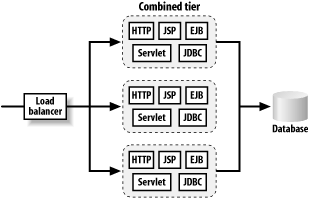Combined-Tier Architecture
The multi-tier architecture illustrated earlier in Figure 14-2 provides many benefits, such as the opportunity to load-balance at the EJB level, and the freedom to add further WebLogic instances at either the presentation or object tier. Simpler cluster architectures can be designed by combining the web/presentation and object tiers into a single WebLogic cluster. This means deploying the entire application (including servlets, JSPs, EJBs, RMI objects, JDBC, and JMS resources) homogeneously across all members of the WebLogic cluster. Figure 14-8 depicts the layout of the combined-tier architecture. Here, each server instance in the tier hosts all of the aforementioned services, including the HTTP server.

Figure 14-8. Combined-tier architecture
An obvious benefit of such an architecture is the ease with which it can be constructed and administered. You can deploy your application and its components to all members of the cluster. The network configuration of this setup also is simplified, as are your security considerations. By placing a firewall before the load balancer, you can set up a DMZ for your application quite simply. If you need to disable direct access to your EJB objects, you also can configure WebLogic to disable all external T3/IIOP requests to the cluster.
The combined-tier architecture also performs quite well. Because servlets and EJBs are ...
Get WebLogic: The Definitive Guide now with the O’Reilly learning platform.
O’Reilly members experience books, live events, courses curated by job role, and more from O’Reilly and nearly 200 top publishers.

